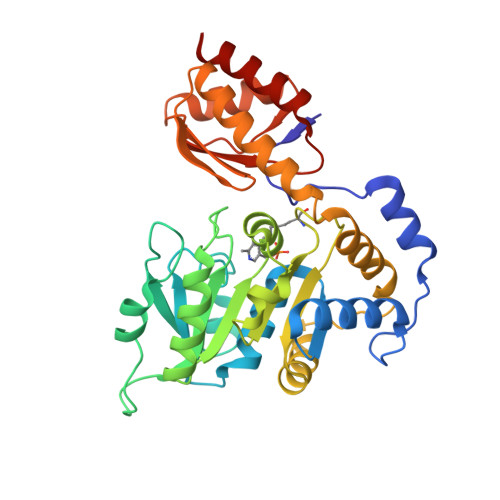Molecular basis of E. colil-threonine aldolase catalytic inactivation at low pH.
Remesh, S.G., Ghatge, M.S., Ahmed, M.H., Musayev, F.N., Gandhi, A., Chowdhury, N., di Salvo, M.L., Kellogg, G.E., Contestabile, R., Schirch, V., Safo, M.K.(2015) Biochim Biophys Acta 1854: 278-283
- PubMed: 25560296
- DOI: https://doi.org/10.1016/j.bbapap.2014.12.023
- Primary Citation of Related Structures:
4RJY - PubMed Abstract:
L-Threonine aldolases (TAs), a family of enzymes belonging to the fold-type I pyridoxal 5'-phosphate (PLP) dependent enzymes, play a role in catalyzing the reversible cleavage of l-3-hydroxy-α-amino acids to glycine and the corresponding aldehydes. Threonine aldolases have great biotechnological potential for the syntheses of pharmaceutically relevant drug molecules because of their stereospecificity. The pH-dependency of their catalytic activity, affecting reaction intermediates, led us to study the effect of low-pH on Escherichia coli TA (eTA) structure. We report here a low-pH crystal structure of eTA at 2.1 Å resolution, with a non-covalently bound uncleaved l-serine substrate, and a PLP cofactor bound as an internal aldimine. This structure contrasts with other eTA structures obtained at physiological pH that show products or substrates bound as PLP-external aldimines. The non-productive binding at low-pH is due to an unusual substrate serine binding orientation in which the α-amino group and carboxylate group are in the wrong positions (relative to the active site residues) as a result of protonation of the α-amino group of the serine, as well as the active site histidines, His83 and His126. Protonation of these residues prevents the characteristic nucleophilic attack of the α-amino group of substrate serine on C4' of PLP to form the external aldimine. Our study shows that at low pH the change in charge distribution at the active site can result in substrates binding in a non-productive orientation.
Organizational Affiliation:
Department of Medicinal Chemistry, School of Pharmacy, Institute for Structural Biology and Drug Discovery, Virginia Commonwealth University, Richmond, VA, USA.

















